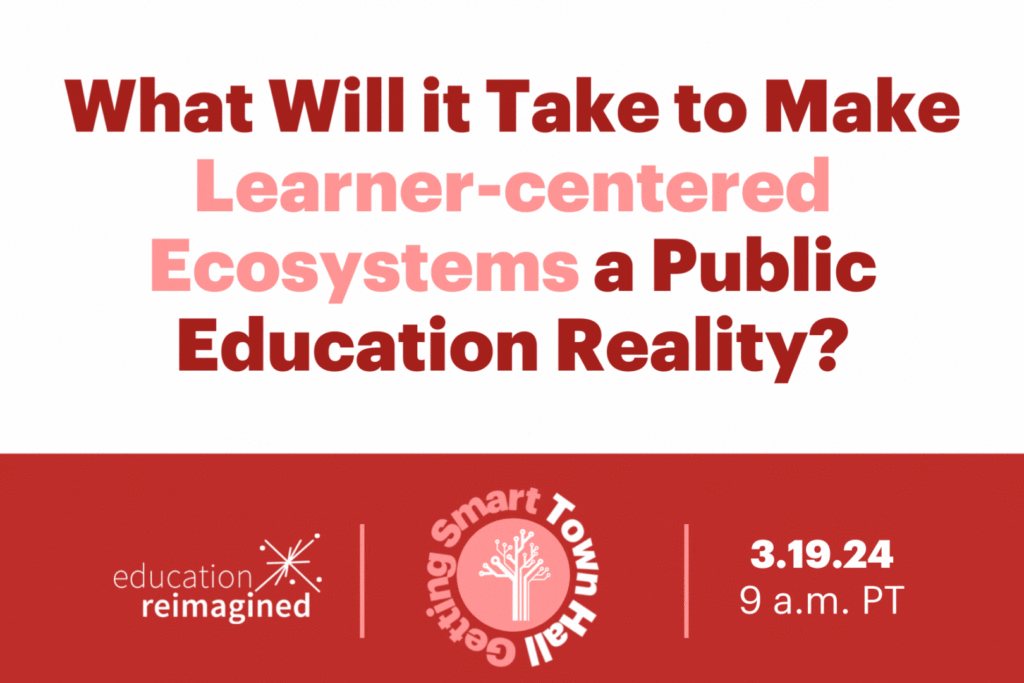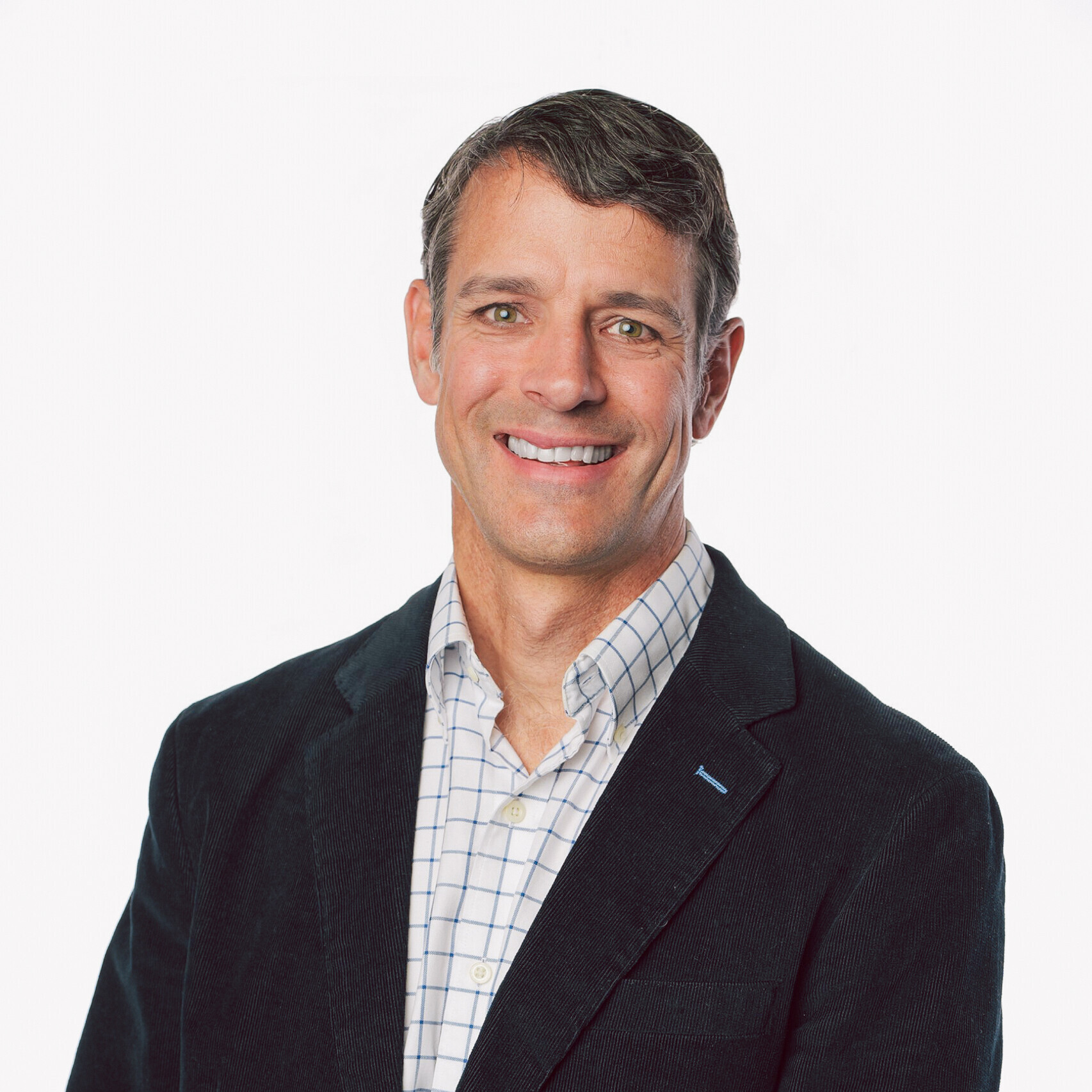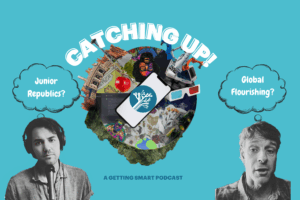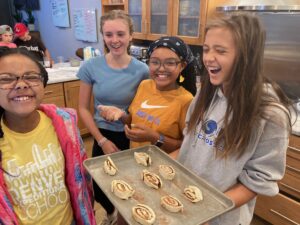Town Hall Recap: Learner-Centered Ecosystems as a Public Education Reality?

On this Getting Smart Town Hall, we were joined by a fired-up group of organizations working to make learner-centered ecosystems a reality for public education. We heard why transformation at the systems level is urgent, what possibilities these learner-centered ecosystems pose as a path forward, and how R&D efforts are being mobilized for exploration, design, and implementation in communities today and tomorrow.
We kicked off with Karen Pittman, Knowledge to Power Catalysts, on the demand for such ecosystems. Then, Emily Liebtag, Education Reimagined, shared about community-based models, passing to Annalies Corbin, PAST Foundation, who shared about implementing changes in Ohio. Lastly, Val Brown, Carnegie Foundation for the Advancement of Teaching, emphasized the need for regional support. Together, they highlighted collaboration, coalition-building, and balancing learner-driven goals with community needs in education frameworks.
The event ended with a Q&A where participants explored pilot programs to make schools flexible and responsive to diverse learners and regional needs.
The transcript below has been edited for clarity and readability.
Helpful Ecosystem Links:
- Ecosystems for the Future of Learning
- Too Essential to Fail
- Columbus EcosySTEM Initiative
- Designed to Thrive – resources to guide ecosystem readiness and consideration
- Where Does Work to Imagine a Learner-Centered Ecosystem Begin?
- Emily Liebtag’s Voyager post
- XQ Competency Navigator
- XQ First Class
Slide Deck
Recorded Town Hall
Annotated and Adjusted Transcript
Introduction
Nate McClennen
Welcome, everyone, to this dynamic town hall discussion. I’m Nate McClennen from Getting Smart, where I focus on strategy and innovation. We’re here to delve into the critical topic of transforming the concept of learner-centered ecosystems into a tangible public education reality.
Let me set the stage with a brief overview: Our journey into learning ecosystems broadly involves a strategic process of unbundling. This means dissecting existing educational structures into their component parts, including in-school and out-of-school systems, and reorganizing them around new competencies relevant to the local region and the learners themselves. This process of unbundling, followed by designing new learning experiences and competencies, is crucial. Equally important is how we then curate these experiences to ensure they are accessible to all learners, guiding them with the help of coaches and learning advisors to navigate through the myriad pathways that best suit their individual needs.
This approach is fundamental to crafting meaningful and personalized ecosystems of learning. Now, to give you a roadmap of today’s discussion, we’re breaking it down into four focused segments:
- The Why: Karen Pittman will kick us off by exploring the demand for learner-centered ecosystems. Karen brings a wealth of experience from her advisory role at Education Reimagined and her extensive career with the Forum for Youth Investment, focusing on youth development ecosystems. She currently leads Knowledge to Power Catalysts, showcasing her deep expertise in this field.
- The What: Emily Liebtag, Chief Innovation Officer at Education Reimagined, will define what community-based, learner-centered ecosystems entail. Emily is a passionate advocate for learner-centered education, with whom I’ve had the pleasure of collaborating on place-based initiatives at Getting Smart.
- The How: We’ll then hear from Annalies Corbin in Columbus, Ohio, who heads the PAST Foundation. Annalies has been pioneering in creating STEM learning ecosystems, working closely with Ed Reimagine and other partners to integrate real-world experiences into learning.
- The Support: Finally, Val Brown from the Carnegie Foundation for the Advancement of Teaching will address the significance of these ecosystems and why they merit our collective support and attention, touching upon the foundation’s work in fostering regional ecosystem zones.
With that introduction, I’ll now pass the microphone to Karen to begin our exploration into why learner-centered ecosystems are an urgent and current need.
The Why (03:32)
Karen Pittman: Thank you for sharing. I’m excited to join this discussion. With only five minutes, I’ll quickly dive into some key points from the paper I co-authored with Education Reimagined, titled “Too Essential to Fail.” This work consolidates extensive evidence supporting the timely necessity for educational transformation, underscored by public demand. Our analysis extends beyond the US, incorporating insights from the OECD’s future learning scenarios, particularly the concept of schools as learning hubs, which is crucial for achieving equity.
We begin by examining public surveys spanning over ten pages, reflecting the consensus among various stakeholders—including business leaders, parents, students, teachers, and out-of-school time leaders—on the need for community-based learning. Highlighting the student perspective is vital; their voices underscore the urgency of connecting education with real-world experiences, as the majority express that current school offerings lack relevance to their interests and future aspirations.
Our discussion also references Thomas Arnett’s work on the K-12 value proposition, contrasting traditional educational metrics with what stakeholders actually value. Interestingly, attributes like universal access to standardized curriculum and assessments hold less importance to parents and the public compared to more personalized and community-integrated educational experiences.
Furthermore, when considering the transition from traditional school systems to community-engaged ecosystems, it’s essential to acknowledge the complexity of the community beyond a simplistic peripheral view around schools. Drawing on a model developed by the National League of Cities during the pandemic, we explore how communities can support learning hubs, emphasizing the diverse opportunities for learning that extend beyond academic instruction.
The journey from systems to ecosystems involves reimagining the interplay of people, places, and possibilities, as highlighted by the work of Tom Akiba and Maria Hecht at the University of Pittsburgh. This reimagining necessitates viewing learning ecosystems as dynamic networks of relationships and resources, transcending the boundaries of conventional schooling.
In conclusion, understanding the science of learning and development reveals the vast potential of young people, which can only be fully realized through a holistic approach that leverages all aspects of the community. I’ll now pass the discussion to my colleague, Emily, who will delve deeper into defining these ecosystem elements.
The What (08:11)
Emily Liebtag: I’ll be discussing what our concept looks like in practical application. Both in the United States and globally, numerous organizations, including ours, are examining the practical implementations of our educational theories. Karen highlighted two critical points: first, there is evidence that people’s values and expectations for K-12 public education are evolving, and second, there is a need to identify the systems and structures capable of supporting this new paradigm of education.
Drawing from decades of community engagement, we, like many of you, believe that an education system which embraces flexibility, aligns with learners’ interests, and incorporates real-world learning, purpose, and connectedness, exemplifies a learner-centered approach. At Education Reimagined, we define the pinnacle of this approach as encompassing five elements:
- Learner agency,
- Social embeddedness within the community,
- Personalization, relevance, and contextualization,
- Open-walled settings that integrate community into learning,
- Competency-based progression that addresses a comprehensive array of needs and outcomes.
Across the nation, there are models that successfully align these values with teaching and learning methodologies, embodying what we term learner-centered education. This approach not only aligns with the first requirement Karen mentioned—matching education with evolving values—but also addresses the challenge of systematizing and making such educational models publicly and equitably accessible. However, achieving this has not been straightforward.
Despite the emergence of successful examples of learner-centered education, systemic barriers ranging from policy, funding models, to credentialing processes have historically impeded the widespread adoption and accessibility of such educational models in the United States. This represents a significant challenge, but also an opportunity for innovative thinking about accessibility for all interested parties. We propose the concept of learner-centered ecosystems as a solution capable of addressing both identified needs. This approach encompasses five components of a comprehensive system that merges various educational spaces and experiences into a cohesive structure, offering young learners what they need throughout their day.
This ecosystem encompasses more than diverse physical locations; it signifies a holistic learning journey guided by advisors who assist young individuals in navigating their educational pathways within their communities. The key components of a learner-centered ecosystem include:
- Learning hubs (e.g., museums, libraries, and other public institutions) offering daily educational opportunities,
- Home bases where learners, together with their peers and guided by advisors, explore their educational paths,
- Field sites providing career-connected experiences to complement their learning journey.
For a learner-centered ecosystem to truly transform public education, it must be publicly funded, integrate out-of-school learning experiences into the educational journey, and recognize learning achievements from various settings. Without these elements, we risk maintaining a status quo where educational experiences are fragmented and fail to meet learners’ comprehensive needs. The essential components we’ve outlined are crucial for building an ecosystem that significantly diverges from traditional models, ensuring every young person receives the education they need, rather than limiting exceptional opportunities to a privileged few.
Transforming transportation, policies, credentialing processes, and redefining the role of educators are among the systemic changes necessary for making this vision a reality. Encouragingly, we are drawing insights from various ecosystems across the United States already demonstrating the potential impact of such an approach on learners and their families. Displayed on the screen are some of the communities we’re collaborating with, alongside partners on this call such as History Co:Lab and Carnegie Foundation.
We’re eager to learn from more communities engaging in similar initiatives, as learner-centered ecosystems can originate from various settings, including out-of-school programs, after-school activities, or homeschool cooperatives. This diversity offers valuable learning opportunities from fields outside the traditional K-12 system. Next, Annalies will provide a closer look at how these concepts are being implemented on the ground.
The How (14:35)
Annalies Corbin: Thank you very much. I’m truly grateful for this opportunity and extend a heartfelt thank you to Emily and Karen for setting the stage. We are excited to introduce the Columbus EcosySTEM innitiative, innovatively powered by the PAST Foundation. Our unique blend of anthropologists, educators, engineers, designers, and architects unite to reimagine the future of teaching, learning, and work by posing novel questions. At our core, we are passionate about educational research and development, focusing on design, development, and prototyping.
Ohio is experiencing significant industrial and infrastructural growth, with numerous companies choosing to make it their home. This growth, dubbed “Amp it up,” is our response to the state’s burgeoning industry, particularly in advanced manufacturing, IT, and broadband expansion. The arrival of companies like Intel, Honda, Amgen, Amazon Web Services, and Meta has sparked a need for a diverse and skilled workforce.
In October of last year, the Past Foundation, alongside 100 Roads and Education Reimagined, announced the Columbus Learning Ecosystem initiative. This initiative aims to address workforce needs while focusing on individual student development and a sense of belonging. As anthropologists, we emphasize identity formation and career development at the learner’s level, striving to serve as a catalyst for community-wide adoption of various educational prototypes.
Without delving into specifics, it’s crucial to note our focus on creating opportunities within community organizations and traditional school settings, emphasizing learner-centered approaches. Our pilot phase has explored a hybrid model, combining physical and virtual spaces for student interaction, and engaging industry partners to overcome barriers like transportation.
We’ve initiated several projects, including home bases that cater to student needs through regular meetings with learning advisors. Collaborations have spanned homeschool cohorts, after-school programs, and high school workforce cohorts, all aimed at integrating real-world experiences with educational pathways.
A partnership with the ed tech company StartSOLE has enabled us to document these learning experiences, facilitating students’ progress towards high school graduation and beyond. Looking ahead, we’re excited about launching early micro school cohorts, including an IT microschool with the University of Cincinnati and LGBTQ+ cohorts, among others, all powered by Past.
Our R&D enthusiasm drives us to disseminate best practices across the broader educational ecosystem. We’re developing a playbook for home bases and establishing feedback loops to refine our approach in real time. This work is crucial for adapting our models to suit diverse community needs, recognizing that one size does not fit all.
Through collaborations with community Share, Wild Learning, Big Picture Learning, and others, we’re sharing our insights statewide. Our goal is to empower communities, including those in rural areas, to adapt and adopt elements of the Columbus ecosystem in ways that best fit their unique contexts.
I’ll now hand it over to my colleague, Val, to continue this discussion. Thank you for your attention.
The Support? (23:19)
Val Brown: Thank you all. And as I’m looking at my panelists, I want to wish you all a Happy Women’s History Month. I deeply appreciate being here today and would like to thank Emily and Karen for setting the stage. I’m currently reading “Jim Crow’s Pink Slip” by Dr. Leslie Fenwick, which discusses the impact of Jim Crow and Brown vs. Board of Education on the loss of 100,000 Black educators and administrators. Dr. Fenwick highlights how students of color lost critical role models who guided them through navigating life as part of an oppressed group. This underscores why building supportive ecosystems is essential, not only for workforce preparation but to ensure our children recognize their value within their communities.
At the Carnegie Foundation, our mission is to catalyze transformational change in education, ensuring every student has the opportunity to live a healthy, dignified, and fulfilling life. We acknowledge that the current system fails to provide this for every child. For instance, my son recently expressed feeling a sense of freedom just by leaving school for a dentist appointment, signaling that our educational environments might be too restrictive. This observation reinforces our commitment to reimagining education.
Carnegie has been involved in educational reform for over a century, notably through the development of the Carnegie unit. However, we recognize that learning cannot be confined to traditional measurements and that students thrive in environments supported by multiple adults. Our future learning portfolio, developed in collaboration with partners like the XQ Institute, focuses on creating meaningful learning experiences, learning from successful models, collaborating with post-secondary institutions, and building an evidence base to support these changes.
Active hope, a concept promoted by Joanna Macy, is about being an active participant in the change we wish to see. In our work with R&D groups and in systems across Indiana, Arizona, and New Mexico, we’ve observed innovative practices such as schools without walls and strong student-adult relationships that contribute to a sense of belonging. These examples, along with efforts like NACA Academy‘s community-based approach, demonstrate the power of tailored educational ecosystems.
However, these innovations cannot succeed without well-prepared educators. Rethinking professional learning to support competency-based education is crucial. Using tools like the XQ Competency Navigator can help educators identify and develop the skills necessary for leading social movements and fostering community engagement among students.
As we continue to push for educational transformation, we invite collaboration and support from all stakeholders. Our goal is not only to reimagine the role of educators but to ensure every student benefits from an education system that truly meets their needs. Thank you for your engagement and dedication to this work. Nate, I’ll hand it back to you.
Nate McClennen: Hey, we just built a profile of a learner based on Val’s prompt, so kudos to everybody for that. We can take it from the chat and build a progression around it.
- collaboration
- agency
- Communication!
- courage
- Empathy
- fearless
- Courage
- compassion
- communication
- Collaboration
- Empathy
- Effective communication
- Creativity
- courage
- Courage
- Advocacy
- The ability to tell a story!
- Resilience
- Creativity
- Persuasive communication
- Listening
- persistence
- Empathy
- Listening…
- metacognition
- agency based in values and identity
- Knowing yourself
- Resilience
- Co-creation, collaboration, humility
- Active listening
- Being curious
- agency
- Shared power
- creativity
- resilience
- Experimental mindset
- Humility
- Design Thinking
- We just built a Profile of a Learner!
- cultural competencies
- Systems thinking
- Active listening, curiosity, ASKING
- Mindfulness
- equity
- Sedlacek’s 8 “non-cognitive” competencies.
Question & Answer (31:58)
Nate McClennen: There were a lot of great comments, so we won’t get to all of them, but I want to highlight a few important points. I’ll call on you, so please be succinct in your explanations, answers, or questions so we can include as many people as possible.
I want to start with Vriti, who asked a great question about documentation. “This is all amazing, but how do we capture all the evidence along the way?” So, Vriti, would you please rephrase your question? Then, Scott Bess from Purdue, I’d like you to answer it, especially regarding the diploma, the small step you’ve taken, and see where we go from there. So, Vriti, go ahead.
Vriti Saraf | ed3DAO: Thank you. There are two elements to consider: obviously, competency-based learning and the stacking of credentials are important, but so is the ownership of the credentials. If you’re decentralizing learning and creating learning hubs across the city, then no single institution should own those credentials. Those are the two viewpoints I’m coming from.
Nate McClennen: Yeah, love it. Self-sovereignty is a significant design aspect happening, and Vriti is at the center of that with Ed3 DAO work, etc. Look her up if you have questions about that.
So, Scott, a small step in that direction in Indiana regarding the diploma?
Scott Bess | Purdue Poly: Like many people on this call, you’re doing innovative things around ecosystems and keep bumping up against state requirements. It’s really hard work and exhausting. I leveraged my position on the State Board of Education to push for a diploma redesign. We’re moving towards foundational elements for all students but then opening it up completely. To Val’s wonderful presentation, it moves away from the Carnegie unit driving everything because it incorporates the ideas in our portrait of a graduate into the diploma itself for the first time.
If the portrait of a graduate isn’t part of your diploma, you’re just hoping some of that stuff happens. You’re not really driving towards it. So, we’re unveiling this next Wednesday. We think it’s going to make it easier for schools doing innovative things and wanting to push the envelope, allowing these ecosystem models to exist without requiring a driving personality, enabling traditional district schools to now have air cover from the diploma.
Nate McClennen: There are some early examples like the seal of biliteracy in some states, but no massive advances. So, I’m looking forward to seeing what happens in Indiana. Scott, it’s a step in the direction where we make the diploma look a bit different. Moving to a question from Robert about cohorts versus home bases. Emily, you talked about structures, and he had some good questions. Can you share any differentiators?
Emily Liebtag: We view home bases as central hubs that could host multiple cohorts or advisories, similar to Big Picture Learning or the Met. You could have multiple learning cohorts within a home base operating simultaneously. I hope that clarifies your question, Robert. If not, feel free to ask further.
Nate McClennen: Robert, does that address your question? I was trying to understand if being in a cohort could be socially limiting or if it might replicate the age band limitations we’ve seen for years. I wondered what it means to be in an interest or issue-based cohort or identity-based cohort.
Emily Liebtag: Absolutely. The intention is that if a learner’s journey progresses, they may not stay in the same cohort or advisory for an entire year if it’s not a good fit. Annalies is experimenting with this in her cohorts, where some are interest-based and others competency-based, reflecting learners’ needs or goals. The flexibility absent in the current K-12 system would be enacted in an ecosystem approach, ensuring we don’t recreate the issues Robert described or perpetuate non-beneficial age bands.
Nate McClennen: Thank you for those insights. Switching to a comment from Mara Simmons about the tension between learner-centered approaches, where learners set their own goals, and community or regionally based ecosystem needs that might be reflected in a profile of a learner. I wonder if any of the panelists or attendees could discuss navigating this tension when you have top-down but still regionally relevant competencies connected to learning experiences, alongside completely student-driven goals. Val, would you like to tackle that?
Val Brown: Yes, and this learning comes from Kara Bobroff (and Danielle Gonzalez) of NACA Academy. I asked her how you get the community on board, and she was perplexed by the question because, for her, the community was already engaged due to the extensive groundwork laid. It’s essential not to overlook the time and effort required to achieve this alignment. Communities are aware of what their young people need, both economically and holistically. This understanding doesn’t detract from allowing young people to pursue their interests; it’s a both/and situation we can achieve, but it requires time.
The study of social movements gives me hope. Understanding that systemic change takes time, we must persist and remain engaged, even when it’s difficult. Constantly engaging the community ensures ownership and sustainability of the ecosystem. Karen, I’d love to hear your thoughts on this.
Karen Pittman: I agree entirely. It’s crucial to provide people with new ways to connect and language that helps reconcile these approaches as complementary rather than opposing. For example, the XQ competencies do a great job of showing how academic standards map into foundational knowledge, literacies, and the broader competencies needed for graduates. There’s no tension when these elements are integrated, allowing us to free up time for learners to pursue their interests without compromising on foundational learning.
An anecdote that stands out is from an XQ school where students engaged in project-based learning expressed concerns about not learning in traditional ways. Upon taking an end-of-year exam, they realized they had learned a lot, challenging the perception that learning only occurs through direct instruction. We must continually find ways to break down this misconception.
Nate McClennen: These discussions remind me of work at Getting Smart, where we embedded the self-portrait within the portrait of a graduate, allowing for learner-centered interests to be balanced with community-centered goals. This might align with what XQ talks about. So, Diana, considering your comments about inquiry schools and the Philly project focused on purpose, this seems relevant. Could you add to this discussion?
Diana Laufenberg: Absolutely. The project in Philadelphia is a collaborative effort among Inquiry Schools, the Philadelphia Learning Collaborative, and experts steeped in purpose-driven work. It involves five schools engaging students, teachers, and advisors in community-based projects, emphasizing purposeful engagement and meaningful opportunities. The goal is to connect students with activities that allow them to explore their interests and how they wish to engage with their community. The project, funded by the John Templeton Foundation, is concluding this spring unless additional funding is secured. A research paper and an upcoming event, PurposeCon, will showcase the student work and experiences generated from this initiative.
Nate McClennen: Thank you, Diana, for clarifying. As we wrap up, I’d like to acknowledge the expertise of many attendees beyond our panelists. There’s significant work being done in ecosystems across the country, from FabNewport to Spark NC and others. Collaboration and connection among us can only enhance our collective efforts.
In conclusion, three key takeaways: Val’s insight that freedom shouldn’t equate to leaving school, the importance of coalitions and collaborations, and the value of piloting and prototyping to innovate within educational ecosystems. This town hall has reinforced that transformation is not only possible but already happening, encouraging us to expand and deepen our collaborative efforts for a more inclusive and learner-centered education system.








Sheryl Morris
This is so exciting! Having watched online and studied educational alternatives and some of the growing coalitions AND having grown frustrated with seemingly fractious movement I see things ARE coming together! I began with studying Montessori and then expanded to explore what is called “holistic education,” simply put is nurturing mind, body, and spirit. I have discovered scholars looking again at the pivotal work of James Moffett who wrote among other work, “The Universal Schoolhouse.” It was a missed opportunity in the 1990s to not see through to completion his vision, maybe now is the time. Feedback loops of which you speak are important to capture the “Warm Data” Nora Bateson speaks of as we proceed. I love Val Brown who I see and hear on the Integrated Schools podcasts. I know of Karen Pittman from “The Future of Smart” podcast with Dr. Ulcca Joshi Hansen. I am hoping my city of Minneapolis will jump at the opportunities that are here. Thank you!